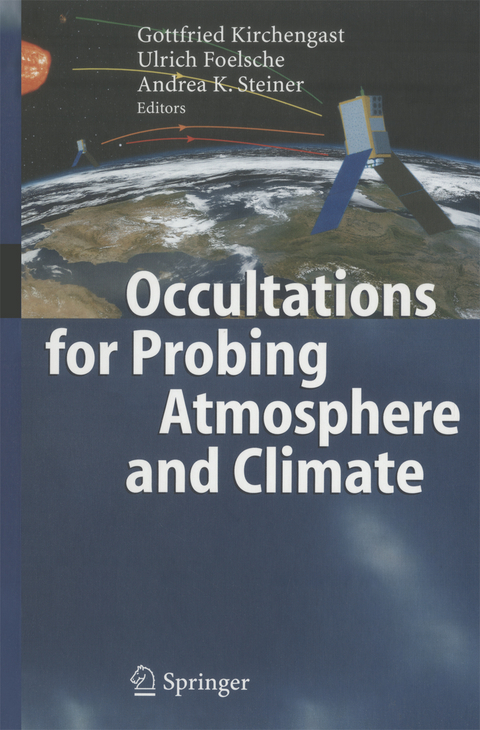
Occultations for Probing Atmosphere and Climate
Springer Berlin (Verlag)
978-3-642-06108-0 (ISBN)
Occultations for Probing Atmosphere and Climate: Setting the Scene.- 1. Occultation Methodology in General.- Wave Optics Algorithms for Processing Radio Occultation Data in the Lower Troposphere: A Review and Synthesis.- The Radio-Holography Approach for GNSS Occultation Data Analysis: Review and Application to Resolving Fine Structures in the Atmosphere and Mesosphere.- Open Loop Tracking and Inverting GPS Radio Occultation Signals: Simulation Study.- Fourier Analysis of GNSS-LEO Radio Occultation Signals, Resolution and Limitations.- Canonical Transform Methods for Radio Occultation Data.- Unfolding of Radio Occultation Multipath Behavior Using Phase Models.- Abel Integral Inversion in Occultation Measurements.- Does a Priori Information Improve Occultation Measurements?.- Retrieval of Atmospheric Refractivity Profiles from Ground-Based GPS Measurements.- 2. GNSS-LEO Occultation.- GRAS-SAF Radio Occultation Data from EPS/Metop.- Deviations from a Hydrostatic Atmosphere in Radio Occultation Data.- Sensitivity of GNSS Occultation Profiles to Horizontal Variability in the Troposphere: A Simulation Study.- Advancement of GNSS Radio Occultation Retrieval in the Upper Stratosphere.- Ensemble-Based Analysis of Errors in Atmospheric Profiles Retrieved from GNSS Occultation Data.- Refractivity Profiles Obtained by Abel Inversion from a Down Looking GPS Radio Occultation Experiment at Mt. Fuji: Preliminary Results and Future Plan.- 3. LEO-LEO Occultation.- An Active Microwave Limb Sounder for Profiling Water Vapor, Ozone, Temperature, Geopotential, Clouds, Isotopes and Stratospheric Winds.- An Overview of the University of Arizona ATOMS Project.- The ACE+ Mission: An Atmosphere and Climate Explorer Based on GPS, GALILEO, and LEO-LEO Radio Occultation.- Simulating theInfluence of Horizontal Gradients on Retrieved Profiles from ATOMS Occultation Measurements - A Promising Approach for Data Assimilation.- Water Vapor Profiling Using Absorptive Occultation Measurements: A Comparison Between SAGE III and ATOMS.- The Genesis of the ACE+ Anti-Rotating Satellites Concept.- 4. Stellar and Solar Occultation.- The Stellar Occultation Technique: Past Achievements, Recent Developments, and Future Challenges.- Envisat/GOMOS Stellar Occultation: Inversion Schemes and First Analyses of Real Data.- Atmospheric Density, Pressure and Temperature Profile Reconstruction from Refractive Angle Measurements in Stellar Occultation.- Stratospheric Temperature and Ozone Sounding with ENVISAT/GOMOS Stellar Occultation.- Information Approach to Channel Selection for Stellar Occultation Measurements.- The Solar Occultation Mission ACE: An Overview.- Mesospheric Temperature and Ozone Sounding by the SMAS Solar Occultation Sensor.- 5. Use of Occultation Data.- Utility of Occultations for Atmospheric Wave Activity Studies: Results of GPS/MET Data Analyses and Future Plan.- Stratospheric Gravity Wave Fluctuations and Sporadic E at Mid-Latitudes with Focus on Possible Effects of the Andes.- The Detection of Upper Level Turbulence via GPS Occultation Methods.- Evaluation of Refractivity Profiles from CHAMP and SAC-C GPS Radio Occultation.- Ionospheric Radio Occultation Measurements and Space Weather.- The Mars Atmospheric Constellation Observatory (MACO) Concept.- Author Index.
| Erscheint lt. Verlag | 30.11.2010 |
|---|---|
| Zusatzinfo | X, 408 p. 265 illus., 35 illus. in color. |
| Verlagsort | Berlin |
| Sprache | englisch |
| Maße | 155 x 235 mm |
| Gewicht | 629 g |
| Themenwelt | Naturwissenschaften ► Geowissenschaften ► Geologie |
| Naturwissenschaften ► Physik / Astronomie ► Astronomie / Astrophysik | |
| Naturwissenschaften ► Physik / Astronomie ► Relativitätstheorie | |
| Schlagworte | Atmospheric remote sensing • atmospheric sciences • climatology • Cloud • Inversion • Ionospheric and planetary research • Occultation methods • Radio and optical occultation • Satellite • Temperature • troposphere • Weather • Wind |
| ISBN-10 | 3-642-06108-7 / 3642061087 |
| ISBN-13 | 978-3-642-06108-0 / 9783642061080 |
| Zustand | Neuware |
| Haben Sie eine Frage zum Produkt? |
aus dem Bereich


